
Electronic, optical, and transport properties of widegap II-VI semiconductors PDF
Preview Electronic, optical, and transport properties of widegap II-VI semiconductors
ELECTRONIC, OPTICAL,ANDTRANSPORT PROPERTIESOFWEDEGAPII-VISEMICONDUCTORS By J1ANZHONG LI ADISSERTATIONPRESENTEDTOTHEGRADUATESCHOOL OFTHEUNIVERSITYOFFLORIDAFNPARTIALFULFILLMENT OFTHEREQUIREMENTS FORTHEDEGREEOF DOCTOR OFPHILOSOPHY UNIVERSITY OFFLORIDA 1997 Dedicatedtomy belovedChinaandfamily ACKNOWLEDGMENTS Theauthorwouldliketothankhisthesisadvisor,ProfessorC.J.Stanton,forguidance andencouragementthroughoutthecourseofthisthesis. Alsotheauthorwouldliketo thankProfessorK.A.MuttalibforwholeheartedsupportduringhisyearsattheUniversity ofFlorida. Theauthorishonoredandgrateful tohaveProfessorsJohnR. Klauder, DavidH. Reitze,andJosephH.Simmonsserveonhissupervisorycommittee. Professors J. H. Simmons, R. M. Park and P. H. Holloway are instrumental to thisthesisbyprovidingexperimentaldataanddiscussions. Dr. G.D. Sandersoffered immeasurableassistancewheneverneeded. Dr. V.J.Sosagreatlyimprovedtheaccuracy oftheXPS data. The author appreciates a dissertation fellowship from the Threadgill family and enjoyed every minute during his stay at the Mikroelektronik Centret (MIC) at the Technical University ofDenmark. Gratitudegoestothosefriendswhoplayedsoccerandbridgewiththeauthorduring theseyears;tothoseofficemateswhosharedtheirthoughtswiththeauthor;andtothose secretariesinthePhysicsoffices,inparticular,JulieSmithandCathyKnudsen,without whose technical assistance it would have been impossible for the author to make it through. SpecialthanksgototheGraduateSeminarandpizzas. Lastbutnottheleast,theauthorwouldliketoextendhisappreciationtohisfamily's unlimitedandinvaluableencouragementandsupport. Ill TABLE OF CONTENTS Page ACKNOWLEDGMENTS Hi LISTOFTABLES vii LISTOFFIGURES viii ABSTRACT xjjj PARTS I INTRODUCTION 2 1. OVERVIEW 2 2. IEB-VIACOiMPOUNDSEMICONDUCTORS 8 ZnS 8 ZnSe 12 CdTe 13 II OPTICALPROPERTIESANDXPSSPECTRUMOFZnS 17 3. INTRODUCTION .' 17 4. THEORIES 19 X-rayPhotoemissionSpec—troscopy(XPS) 19 LinearOpticalProperties InterbankTransitionTheory 21 5. RESULTSANDDISCUSSION 24 6. CONCLUSIONS 35 III QUANTUMCONFINEMENTEFFECTSINCdTe 37 7. INTRODUCTION 37 8. THEORIES 44 TruncatedCrystalApproximation 44 EnvelopFunctionApproximation 47 HamiltonianModels 49 3D30x30k pTheory 51 ID2x2k pModel 52 IDWhite-ShamModel 52 IV 9. RESULTS 54 TruncatedCrystalApproximation 55 EnvelopFunctionApproximation 59 10. DISCUSSION 66 TruncatedCrystalApproximation 66 EnvelopFunctionApproximation 68 11. CONCLUSIONS 70 IV STATICSCREENINGANDMOBILITYINn-ZnSe 72 12. INTRODUCTION 72 13. BACKGROUND 75 14. THEORIES 79 ChemicalPotential 79 ElectronicMobilityduetoIonizedImpurityScatterings 82 15. RESULTSANDANALYSIS 86 SeriesA 87 SeriesBandC 101 ExperimentalResults 117 16. DISCUSSION 124 17. CONCLUSIONS 129 V CONCLUDINGREMARKS 132 18. SUMMARY 132 APPENDICES A. EMPIRICAL30x30k-pTHEORY 135 ReducedSchrddingerEquation 135 BasisFunctions 136 MatrixElements 137 B. GILAT-RAUBENHEIMERSCHEME 141 C. GENERALIZEDDEBYETHEORY 144 Basics 144 ApplicationsofGeneralizedDebyeTheory 146 DegenerateElectronGasin3D 146 ClassicalElectronGas 147 V SinglyChargedDonors 147 BIBLIOGRAPHY 148 BIOGRAPHICALSKETCH 155 VI . LIST OFTABLES Table Page 1 CollectionofImportantParametersofZnS,ZnSe,andCdTe,, 9 2. k pResultsforZnSComparedwithExperimentalValues 24 3. 30x30k-pMethodInputParametersforZnS,ZnSe,andCdTe 25 4. QDSizeswith200meVDiscrepancybetweenCalculatedAbsorptionEdges by30x30k pModelandApproximateBandModels 39 5. k-pResultsforCdTeComparedwithReportedValuesinLiterature 51 6. ResultsofCdTeQDsandCalibratedAbsorptionEdgesbyPotter 54 7. ZnSeMaterialParametersUsedintheCalculationsofPartIV 80 8. InputParametersUsedintheCalculationsofPartIV 87 9. DonorandAcceptorConcentrationsintheExperiments 117 10. Empirical30x30k-pTheoryBasisStates 137 11. LinearMomentumParametersfor30x30k pTheory 139 12. AntisymmetricPotentialParametersfor30x30k-pTheory 139 13. Spin-orbitalCouplingParametersfor30x30k-pTheory 140 vll LIST OFFIGURES Figure Page 1. UnitcelloftheFCClatticeofzincblendestructure 4 2. ConnectionsofthePresentDoctoralResearch 7 3. Schematicdiagramofthethin-filmMISIMstructureandbandedgediagramof TFELDunderhighelectricfield. Indicatedarethemainprocesses: tunnel emissionfrominterfacestates,impactexcitationofactivators,impact ionizationofelectron-holepairs,andcaptureatarrivalattheanodeinterface.. 10 4. BandstructureofzincblendeZnSbytheempirical30x30k pmethod. ...26 5. DensityofstatesforzincblendeZnS,calculatedbyGRscheme 28 6. XPSspectrum(darkcurve)andtheoreticalDOScalculationofZnS 29 7. ConvolutedtheoreticalDOS(darkcurve)ofZnSwithaGaussiandistribution ofFWHM=1.25eV 30 8. DielectricconstantsandreflectivityforzincblendeZnS.Realpartofthe dielectricconstantpredominantlycontributestothereflectivity 32 9. Theoreticalreflectivitycomparedwithexperiment. Themeasurementcovers upto9.5eVandthepeakat3.4eVisduetoFabry-Peroteffect 34 10. Comparisonofnon-parabolicmodelwith30x30k pmodelforconduction band. Clearly,previousmodelisunsuitabletodescribecarrierenergieseven at5%offTpoint 40 11. ComparisonofLuttingermodelwith30x30k pmodel. Asshown, LuttingermodelisdeficientinpredictingcarrierenergiesoffTpoint 41 Vlll 12. MeasuredabsorptionedgeofCdTequantumdotscomparedwithcalculated absorptionedge. Theblue-shifteffect,duetokineticconfinement,onthe absorptionedgeisabout 1.0eVat24Aandslightlyoffsetbythered-shift effectduetoCoulombinteraction 43 13. BandstructureofzincblendeCdTecomputedbytheempirical30x30k p method 50 14.TruncatedCrystalApproximation(TCA)resultof30ACdTequantumfilm. TheTCAmethodmapsthequantizedcrosssectionsoftheelectronicstructure ontotheunaffectedplane. Shownarethefirstthreesubbandsfromeachband inthebulk. Reflectedclearlyarethewarpingnatureofthevalencebandsand theliftofthedoubledegeneracyatthetopofthevalencebands 56 15. PredictedbandedgesatsymmetricalpointsofCdTequantumcubebythe TCAmethod. Noinversesquarebehaviorsarefoundandasymptotic saturationofquantumconfinementeffectonthebandedgesispredicted. ... 57 16. PredictedtransitionenergiesofCdTequantumcubebytheTCAmethod. T pointistheabsorptionedgeabove 16Aandthenreplacedbyanunidentified pointinsomegeneraldirection 58 17. ExperimentaldatacomparedwithTCApredictionsforCdTequantumdots. Theexperimentaldataarecorrectedbyconsideringsizedistributionand tunnelingintofiniteglassbarriers. DiscrepancyatlargeLlimitisbecausethe TCApredictionsareforQDsatzerotemperature 60 18. ComparisonbetweennumericalEFAandTCAresults. SolidlinesareEFA calculationswith4meshpointsinfinitedifferencescheme. Insetshows ID 2x2k pmodel,whichisasymptoticallyparabolicforbothbands 62 19. ComparisonbetweennumericalEFAandTCAresults. SoiidlinesareforEFA calculationswith20meshpoints. ComparedtoEFAresultswith4meshpoints (Fig. 18)andTCAresults,noagreementsbetweenEFAresultswithdifferent meshpointsandbetweenEFAandTCAresultshavebeenachieved 63 20. Analytical,numericalandTCAresultsoftheWhite-Shammodel. Straight solidlinesareforviewingguide. Theinsetshowsthebandsaspredictedby theWhite-Shammodel. Excellentagreementshavebeenachievedamongall results 65 21. Derivativeoftheionizeddonorconcentrationwithrespecttothechemical potentialforSeriesA.Itindicatesthescreeningcapabilityoftheionized donors. Atlowtemperature,compensationincreasesthecapabilityasthe filledstatesbecomepartiallyoccupied. Sharptransitionoccursat 26.5K.At hightemperature,the{3factorkicksinandreducesthecapability 90 22. Derivativeofthefreeelectronconcentrationwithrespecttothechemical potentialforSeriesA.Atlowtemperature,thermalexcitationincreasesthe screeningcapabilityofelectronsforsystemsoflowcompensation. Forhighly compensatedsystems,duetoMItransition,theyshowthebehaviorof degenerateelectrons. The(3factoraffectsthescreeninginalltemperature rangebutdominatesathightemperature 91 23.DebyeLength(inA)versustemperatureforSeriesA.Atthecritical temperatureof 26.5K,MItransitionduetostaticscreeningoccursatlow compensation. Thetransitiontemperaturedecreaseswiththeacceptor concentrationandvanishesabovethecriticalacceptorconcentrationwhere thesystembecomesmetallic. Belowthecriticaltemperature,screeningeffect ispredominatedbycompensation. The(3factoreffectweaklyincreasesthe Debyelengthinnon-transitionalregime 92 24. BindingenergyofdonorsversustemperatureforSeriesA.Belowthecritical temperature,donorlevelisreducedasacceptorconcentrationincreases. Away fromthetransitionregion,itincreasesduetothe(3factoreffect 94 25. IonizeddonorconcentrationversustemperatureforSeriesA.Atlow compensation,thermalionizationofdonorsincreasestheionizedpopulation exponentially. Increaseinacceptorconcentrationaccordinglycreatesthesame amountofionizeddonorsatlowtemperature. Abovethecriticalacceptor concentration,ionizeddonorconcentrationincreasesweaklywithtemperature. Thereisslightchangeintheionizeddonorconcentrationabovethecritical temperature 95 26.ChemicalpotentialasafunctionoftemperatureforSeriesA.MItransition occursatacriticalacceptorconcentrationof5x1015cm~3forcompensated systemsoratacriticaltemperatureof26.5Kforuncompensatedsystems. Belowthecriticaltemperatureandthecriticalacceptorconcentration, chemicalpotentialisfrozenaround-13meV.Athightemperature,the chemicalpotentialdecreasestowardsthemiddleofthebandgap 97
